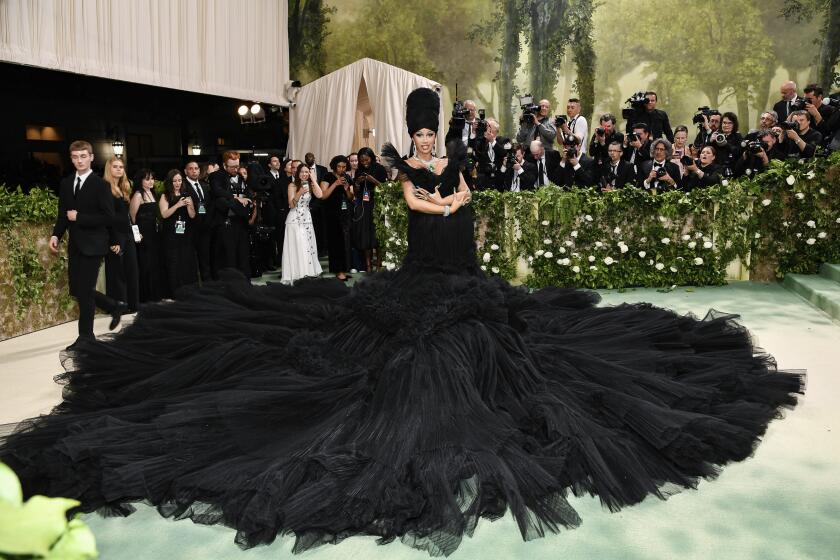Playing the Field
For celebrity-watchers, fashion week has been worse than a badly turned hem. There were no supermodels here, save a fleeting runway glimpse of Shalom and Naomi. There were not many big names either--unless anyone’s counting Gwyneth Paltrow at Dior or Roman Polanski at Cerruti--to reignite the days when Demi Moore would show up with her bodyguards, and Kate, Linda and Christy would pose all day and party all night with equal fervor. In fact, about the only fizz anyone could count on all week came from the Chupa Chups girls, two towering drag queens who dressed in red from their spiky wigs to their 6-inch platforms and handed out lollipops outside every show.
As the spring ’99 collections wrapped up--90 shows scheduled over 10 days--some of the most sharply focused messages in Paris came from a band of Americans: Michael Kors at Celine, Narciso Rodriguez at Loewe and Peter Speliopoulos at Cerruti.
It’s no coincidence. Once upon a time, the Italians tailored suits, the French confected gowns and the Americans cranked out sportswear. Now, with French fashion conglomerates like LVMH Moet Hennessy-Louis Vuitton demanding commerce along with art, they’ve signed on a contingent of 7th Avenue veterans, counting on their sportswear sensibility to ring in the dollars.
In his second season at Celine, Kors has a new shop--an alabaster-and-sycamore boutique that opened last week on Avenue Montaigne--and a new muse. Instead of the jet-set life, Kors said he was inspired here by the “graceful elegance” of Mia Farrow. But his thick hooded cardigans and crisp, white clam diggers seemed to better recall Jackie Kennedy on Martha’s Vineyard--not a bad evocation in a country where the French-speaking first lady was so adored that when she and JFK visited here during his presidency, he referred to himself as the man who accompanied Jacqueline Kennedy to Paris.
Whatever the spark, Kors built his collection around the sweater. For day, there were sleeveless shells and long pullovers hand-knit from hemp yarn or silk paper taffeta. To underscore the sense of luxury, Kors added matching mufflers, worn around the neck like a turtleneck or pulled overhead to frame the face, like Jackie in a silk Hermes scarf. For evening, there were sheer cashmere “sweats,” strapless cashmere sheaths and heavyweight shells worn with sequined organza skirts. But Kors’ signature may be his new twist on the twin set, done here as a long turtleneck with a chunky empire-waisted cardigan.
The clothes don’t shout either at Loewe, where Rodriguez, the young designer who made a name creating a wedding dress for another Kennedy, pared things down to elegant bits of Americana. There were unfettered zip-front jackets, slim sheath dresses, even classic gray pants and oxford shirts with rolled-up sleeves. Of course, since Loewe began as a Spanish leather goods company, Rodriguez, in his second collection for the house, offered up plenty of skins, including pieces that combine fabric and leather, such as cotton jackets hemmed with a suede belt and a V-neck dress with a suede belt wrapped through deeply cut armholes. Also on the runway were beige cardigan suits and a white coat dress with deep neckline.
Like his fellow Americans, Cerruti’s Speliopoulos aimed to keep the collection as spare as the beige walls and white curtains surrounding his runway. But rather than limit himself to monotone basics, Speliopoulos, who landed at Cerruti via Donna Karan two seasons ago, added some dots and dashes of color. In a Gen-X nod to the Information Age, white pants were trimmed with silver and gold “molecular balls,” shells were patterned in techy-looking black hieroglyphics, and pale sheath dresses were covered with metal-colored plastic strips designed to look like computer graphics.
With the three Americans trying to neutralize each other--in terms of color palette, of course--at least there’s Christian Lacroix. This season, he started off in a retro mode, with gray shirtwaists and boat-neck dresses that recalled Donna Reed keeping house in high heels and pearls. But the collection--inspired, not surprisingly, by Kodachromes--didn’t stop there. He goes Rio, in a bright yellow “umbrella” skirt with a black, draped tank top. He goes tropical, in a pink-and-chartreuse striped skirt and mauve T-shirt. And he goes cancan, with awning-striped ruffled skirts and bustiers.
From the giant red sun rising over Jean Paul Gaultier’s runway, it was obvious he was in an Asian state of mind, but all the kimono dresses and the Chinese-woodblock bathing suits don’t mean the bad boy of French fashion wants to banish women to the rice fields. The point here was less literal--not even die-hard fashionistas will be wearing kimonos to work next spring--than inspirational. What Gaultier seems to be after is an easier silhouette. And so his signature pinstripe suits took on a softer shape, with fuller legs, wider sleeves and sometimes even a thin belt, tied around and around the waist obi-style. Similarly, classic double-breasted black suits appeared with kimono-style sleeves, lined in dazzling scarlet silk.
However, none of it equaled the megawattage of Gaultier’s finale: classical violinist and sometime-model Vanessa-Mae, a 20-year-old from Singapore, who strode onto the runway in a luxurious white kimono. She tucked her violin under her chin, struck a few triumphant chords and an even more triumphant pose. It brought down the house--sweet music in a season that certainly needed some.



